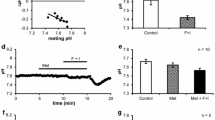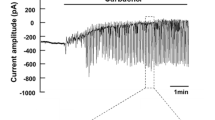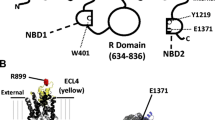Abstract
Even though the same Cl channel (CFTR) is common to certain fluid transport functions that are oppositely directed, i.e., secretion and absorption, only fluid secretion has clearly been shown to be acutely regulated. It is now clear that fluid secretion activated by β-adrenergic stimulation is controlled by cAMP-mediated opening and closing of CFTR-Cl channels. Since the conductance of the human sweat duct is almost wholly due to CFTR-Cl conductance (CFTR-GCl), we sought to determine whether salt absorption via CFTR-Cl channels could also be subject to acute regulation in this purely absorptive epithelium. After α-toxin permeabilization, we found that addition of cAMP resulted in a large increase in Cl diffusion potentials across the apical membrane and a more than twofold increase in the average membrane conductance. Since the cAMP effects were dependent on Cl alone, not on Na, and since apical Cl conductance appears to be almost exclusively comprised of CFTR-GCl, we surmise that this form of electrolyte absorption like secretion is also subject to acute control through CFTR-GCl. Acute regulation of absorption involves both activation by phosphorylation (PKA) and inactivation by dephosphorylation (unknown endogenous phosphatase) of CFTR. Phosphorylation of CFTR was shown by the facts that CFTR-GCl could be activated by cAMP and inhibited by the kinase antagonist staurosporine, or by removal of either substrate ATP or Mg2+ cofactor. Inactivation of CFTR-GCl by endogenous phosphatase(s) was indicated by a spontaneous but reversible loss of CFTR-GCl upon removal of cAMP. Such loss of CFTR-GCl activity could be prevented either by application of phosphatase inhibitors or by using phosphatase-resistant ATP-γ-S as substrate to phosphorylate CFTR. We surmise that absorptive function is subject to rapid regulation which can be switched “on” and “off” acutely by a control system that is common to both absorptive and secretory processes and that this control is crucial to switching between conductive and nonconductive transport mechanisms during salt absorption.
Similar content being viewed by others
References
Al-Bazzaz, F.J. 1986. Regulation of salt and water transport across airway mucosa. Clinics Chest Med. 7:259–275
Anderson, M.P., Berger, H.A., Rich, D.P., Gregory, R.J., Smith, A.E., Welsh, M.J. 1991. Nucleoside triphosphates are required to open the CFTR chloride channel. Cell 67:775–784
Anderson, M.P., Sheppard, D.N., Berger, H.A., Welsh, M.J. 1992. Chloride channels in the apical membrane of normal and cystic fibrosis airway and intestinal epithelia. Am. J. Physiol. 263:L1-L14
Bell, C.L., Quinton, P.M. 1992. Asymmetric permeabilization of an epithelium: A tool to study a single membrane in isolation. J. Tiss. Cult. Meth. 14:165–172
Berger, H.A., Travis, S.M., Welsh, M.J. 1993. Regulation of the cystic fibrosis transmembrane conductance regulator Cl channel by specific protein kinases and protein phosphatases. J. Biol. Chem. 268:2037–2047
Collins, F.S. 1992. Cystic fibrosis: Molecular biology and therapeutic implications. Science 256:774–779
Eckstein, F. 1985. Nucleoside phosphorothioates. Annu. Rev. Biochem. 54:367–402
Fussle, R., Bhakdi, S., Sziegoleit, A., Jensen, T.J., Kranz, T., Wellensiek, H.J. 1981. On the mechanism of membrane damage by Staphylococcus aureus alpha toxin. J. Cell Biol. 91:83–94
Frizzell, R.A., Field, M., Schultz, S.A. 1979. Sodium coupled chloride transport by epithelial tissues. Am. J. Physiol. 236:F1-F8
Gogelein, H. 1988. Chloride channels in epithelia. Biochim. Biophys. Acta 947:521–547
Hawk, C.T., Kudo, L.H., Rouch, A.J., Schaffer, J.A. 1993. Inhibition by epinephrine of AVP and cAMP stimulated Na+ and water transport in Dahl rat CCD. Am. J. Physiol 265:F449-F460
Holtug, K., Shipley, A., Dantzer, V., Knudsen, O.S., Skadhauge, E. 1991. Localization of sodium absorption and Cl secretion in an intestinal epithelium. J. Membrane Biol. 122:215–229
Kartner, N., Augustinas, O., Jemen, T.J., Naismith, A.L., Riordan, J.R. 1992. Mislocalization of ΔF508 CFTR in cystic fibrosis sweat gland. Nature Genetics 1:321–327
Kealey, T. 1988. Phosphorylation studies on the human eccrine sweat gland. In: Cellular and Molecular Basis of Cystic Fibrosis. G. Mastella and P.M. Quinton, Editors, pp. 150–154. San Francisco Press, San Francisco
La, B., Carisi, S.L., Valentich, J., Shenolikar, S., Sansom, S.C. 1991. Regulation of epithelial chloride channels by protein phosphatase. Am. J. Physiol. 260:C1217-C1223
Lew, T.S., Krasne, S. 1991. The only anion selective channel measured in intact sweat ducts has a unit conductance of 8 pS. Pediatric Pulmonol. Supp. 5:A251
Ostedgaard, L.S., Shasby, D.M., Welsh, M.J. 1992. Staphylococcus aureus alpha-toxin permeabilizes the basolateral membrane of a Cl-secreting epithelium. Am. J. Physiol. 263:L104-L112
Quinton, P.M. 1986. Missing Cl conductance in cystic fibrosis. Am. J. Physiol. 251:C649–652
Quinton, P.M., Reddy, M.M. 1989. Cl conductance and acid secretion in the human sweat duct. Ann. NY Acad. Sci. 574:438–446
Quinton, P.M. 1990. Cystic fibrosis: A disease in electrolyte transport. FASEB J. 4:2709–2717
Quinton, P.M., Reddy, M.M. 1991. Regulation of absorption in human sweat duct. In: The Identification of the CF (cystic fibrosis) Gene: Recent Progress and New Strategies. L.-C. Tsui, G. Romeo, R. Greger and S. Gorini, editors, pp. 159–172. Plenum, New York
Quinton, P.M., Reddy, M.M. 1992. Control of CFTR chloride conductance by ATP levels through non-hydrolytic binding. Nature 360:79–81
Quinton, P.M., Reddy, M.M. 1993. The sweat gland. In: Cystic Fibrosis. Pamela Davis, editor. Lung Biology in Health and Disease series; Claude Lenfant, editor, pp. 135–157. Marcel Dekker, New York
Reddy, M.M., Quinton, P.M. 1987. Intracellular potentials from microperfused sweat duct. Pfluegers Arch. 418:471–475
Reddy, M.M., Quinton, P.M. 1991. Intracellular potassium activity and the role of potassium in transepithelial salt transport in human reabsorptive sweat duct. J. Membrane Biol. 119:199–210
Reddy, M.M., Quinton, P.M. 1992. cAMP activation of CF affected chloride conductance in both membranes of an absorptive epithelium. J. Membrane Biol. 130:49–62
Reddy, M.M., Quinton, P.M. 1992. Intracellular Cl activity: Evidence of transient shift from conductive to carrier mediated Cl transport in human sweat duct. Pediatric Pulmonol. Supp. 8:R147
Riordan, J.R. 1993. The cystic fibrosis transmembrane conductance regulator. Annu. Rev. Physiol. 55:609–630
Schaffer, J.A., Hawk, C.T. 1992. Regulation of sodium channels in the cortical collecting duct by AVP and mineralocorticoids. Kidney Int. 41:255–268
Shenolikar, S., Nairn, A.C. 1991. Protein phosphatases: Recent progress. Advances in Second Messanger and Phosphoprotein Research. P. Greengard and G.A. Robinson, editors. 23:1–121. Raven, New York
Silva, P., Stoff, J., Field, M., Fine, L., Forrest, J., Epsrein, F. 1977. Mechanisms of active chloride secretion by shark rectal gland: Role of Na/K-ATPase in chloride transport. Am. J. Physiol. 233: F298-F306
Tabcharani, J.A., Chang, X.-B., Riordan, J.R., Hanrahan, J.W. 1991. Phosphorylation regulated chloride channel in CHO cells stably expressing the cystic fibrosis gene. Nature 352:628–631
Uno, H., Montagna, W. 1987. Catecholamine containing nerve terminals of the eccrine sweat gland of macaques. Cell Tissue Res. 158:1–13
Welsh, M.J. 1983. Intracellular chloride activities in canine tracheal epithelium: Direct demonstration for sodium coupled intracellular chloride accumulation in a chloride secreting epithelium. J. Clin. Invest. 71:1392–1401
Welsh, M.J., Anderson, M.P., Rich, D.P., Berger, H.A., Denning, G.M., Ostedgaard, L.S., Sheppard, D.N., Cheng, S.H., Gregory, R.J., Smith, A.E. 1992. Cystic fibrosis transmembrane conductance regulator: A chloride channel with novel regulation. Neuron 8:821–829
Author information
Authors and Affiliations
Additional information
The authors are grateful to Mr. Kirk Taylor for expert technical assistance, and to numerous volunteer human subjects for participating in the experiments with informed consent. Supported by grants from the National Institutes of Health, DK-41329-04 and the National Cystic Fibrosis Foundation, Z 439.
Rights and permissions
About this article
Cite this article
Ready, M.M., Quinton, P.M. Rapid regulation of electrolyte absorption in sweat duct. J. Membarin Biol. 140, 57–67 (1994). https://doi.org/10.1007/BF00234486
Received:
Revised:
Issue Date:
DOI: https://doi.org/10.1007/BF00234486




